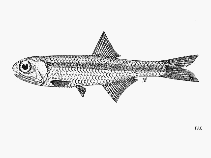Stolephorus andhraensis Babu Rao, 1966
Andhra anchovy
Beobachtung melden im Fish Watcher
| Native range |

|
| This map was computer-generated and has not yet been reviewed. |
| Stolephorus andhraensis AquaMaps Data sources: GBIF OBIS |
Hochladen Photos und videos
Pictures | Google BildStolephorus andhraensis
Photo von FAO
Pictures | Google BildStolephorus andhraensis
Photo von FAO
Klassifizierung / Names Namen | Synonyme | Catalog of Fishes(Gattung, Arten) | ITIS | CoL | WoRMS | Cloffa
> Clupeiformes (Herrings) > Engraulidae (Anchovies) > Engraulinae
Etymology: Stolephorus: Greek, stole, -es = garment + Greek, pherein = to carry (Ref. 45335).
Eponymy: This is a toponym; it refers to the state of Andhra Pradesh, India, the type locality. (Ref. 128868), visit book page.
Etymology: Stolephorus: Greek, stole, -es = garment + Greek, pherein = to carry (Ref. 45335).
Eponymy: This is a toponym; it refers to the state of Andhra Pradesh, India, the type locality. (Ref. 128868), visit book page.
Environment: milieu / climate zone / depth range / distribution range Ökologie
seewasser pelagic-neritic; tiefenbereich 0 - 50 m (Ref. 189). Tropical; 22°N - 15°S, 78°E - 148°E (Ref. 189)
Verbreitung Länder | FAO Gebiete | Ecosystems | Vorkommen | Point map | Einführungen | Faunafri
Indo-Pacific: eastern Indian Ocean (eastern coasts of India around Waltair, but perhaps along most of the coast) and western Pacific (Singapore and Gulf of Papua, but presumably between).
Size / Gewicht / Alter
Kurzbeschreibung Bestimmungsschlüssel | Morphologie | Morphometrie
This species is distinguished by the following set of characters: gill rakers 33-37 (35) in first gill arch with 14-16 (modally 14) in upper series, 19-21 (21) in lower series; gill rakers 26-29 (29) in second gill arch, with 8-11 (10) in upper and 16-19 (19) in lower series; gill rakers 17-19 (19) in third gill arch with 7-8 (8) in upper and 10-11 (10) in lower series; gill rakers 14-16 (14) in fourth gill arch with 5-8 (6) in upper and 8-9 (8) in lower series; branchiostegal rays 10-11 (11); upper jaw long, posterior tip slightly short of or just reaching posterior border of opercle; without predorsal scutes; pelvic scute no spine-like projection; posterior border of preopercle is indented, concave; posterior tip of depressed pelvic fin does not reaching to vertical through dorsal-fin origin; anal-fin origin just below eighth to tenth dorsal-fin ray origin; length of caudal peduncle, 16.9-19.9% of SL, of pectoral fin, 13.2-14.4% of SL and of pelvic fin, 7.4-8.9% of SL. Colouration: with a pair of dark patches behind occiput without a following pair of dark lines; absence of black spots below eye or on lower-jaw tip (Ref. 124189).
Body shape (shape guide): elongated; Cross section: compressed.
Body shape (shape guide): elongated; Cross section: compressed.
Schooling species occurring in coastal waters (Ref. 189, 75154). Eggs are oval, without a knob. More material and data needed.
Life cycle and mating behavior Geschlechtsreife | Fortpflanzung | Ablaichen | Eier | Fecundity | Larven
Hauptreferenz
Upload your references | Referenzen | Koordinator | Partner
Hata, H., S. Lavoué and H. Motomura, 2020. Stolephorus acinaces, a new anchovy from northern Borneo, and redescription of Stolephorus andhraensis Babu Rao, 1966 (Clupeiformes: Engraulidae). Mar. Bio. 50:102. (Ref. 124189)
IUCN Rote Liste Status (Ref. 130435: Version 2024-2)
nicht bedroht (LC) ; Date assessed: 28 February 2017
CITES
Not Evaluated
Bedrohung für Menschen
Harmless
Nutzung durch Menschen
Fischereien: kommerziell
FAO - Publication: search | FishSource |
Mehr Information
Trophic ecology
Food items (preys)
Nahrungszusammensetzung
Nahrungsaufnahme
Food rations
Räuber
Food items (preys)
Nahrungszusammensetzung
Nahrungsaufnahme
Food rations
Räuber
Ecology
Ökologie
Ökologie
Population dynamics
Growth parameters
Max. ages / sizes
Length-weight rel.
Length-length rel.
Längenhäufigkeiten
Mass conversion
Rekrutierung
Dichte
Growth parameters
Max. ages / sizes
Length-weight rel.
Length-length rel.
Längenhäufigkeiten
Mass conversion
Rekrutierung
Dichte
Life cycle
Fortpflanzung
Geschlechtsreife
Maturity/Gills rel.
Fecundity
Ablaichen
Spawning aggregations
Eier
Eientwicklung
Larven
Larven Pop.Dyn.
Fortpflanzung
Geschlechtsreife
Maturity/Gills rel.
Fecundity
Ablaichen
Spawning aggregations
Eier
Eientwicklung
Larven
Larven Pop.Dyn.
Anatomy
Kiemenoberfläche
Brain
Otolith
Kiemenoberfläche
Brain
Otolith
Physiology
Body composition
Nutrients
Oxygen consumption
Swimming type
Swimming speed
Visual pigments
Fish sound
Diseases & Parasites
Toxicity (LC50s)
Body composition
Nutrients
Oxygen consumption
Swimming type
Swimming speed
Visual pigments
Fish sound
Diseases & Parasites
Toxicity (LC50s)
Genetics
Genetik
Heterozygosity
Vererbbarkeit
Genetik
Heterozygosity
Vererbbarkeit
Human related
Aquaculture systems
Aquakultur Profile
Zuchtlinien
Ciguatera cases
Stamps, coins, misc.
Aquaculture systems
Aquakultur Profile
Zuchtlinien
Ciguatera cases
Stamps, coins, misc.
Tools
E-book | Feldführer | Bestimmungsschlüssel | Längenhäufigkeits Tool | Lebensdaten Tool | Punkt Karte | Classification Tree
| Catch-MSY |
Zusatzinformationen
Download XML
Zusammenfassung | Point data | Namen | Photos
Internet Quellen
AFORO (otoliths) | Aquatic Commons | BHL | Cloffa | BOLDSystems | Websites from users | FishWatcher Einträge suchen | CISTI | Catalog of Fishes: Gattung, Arten | DiscoverLife | ECOTOX | FAO - Publication: search | Faunafri | Fishipedia | Fishtrace | GenBank: Genom, nucleotide | GloBI | Google Books | Google Scholar | Google | IGFA World Record | MitoFish | Otolith Atlas of Taiwan Fishes | PubMed | Reef Life Survey | Socotra Atlas | Tree of Life | Wikipedia: Gehe zu, Suchen | World Records Freshwater Fishing | Zoobank | Zoological Record
Estimates based on models
Preferred temperature (Ref. 123201): 27.7 - 29.2, mean 28.6 °C (based on 838 cells).
Phylogenetic diversity index (Ref. 82804): PD50 = 0.5000 [Uniqueness, from 0.5 = low to 2.0 = high].
Bayesian length-weight: a=0.00501 (0.00220 - 0.01140), b=3.14 (2.96 - 3.32), in cm total length, based on LWR estimates for this Genus-body shape (Ref. 93245).
Trophic level (Ref. 69278): 3.2 ±0.4 se; based on size and trophs of closest relatives
Widerstandsfähigkeit (Ref. 120179): hoch, Verdopplung der Population dauert weniger als 15 Monate. (Preliminary K or Fecundity.).
Fishing Vulnerability (Ref. 59153): Low vulnerability (10 of 100).




